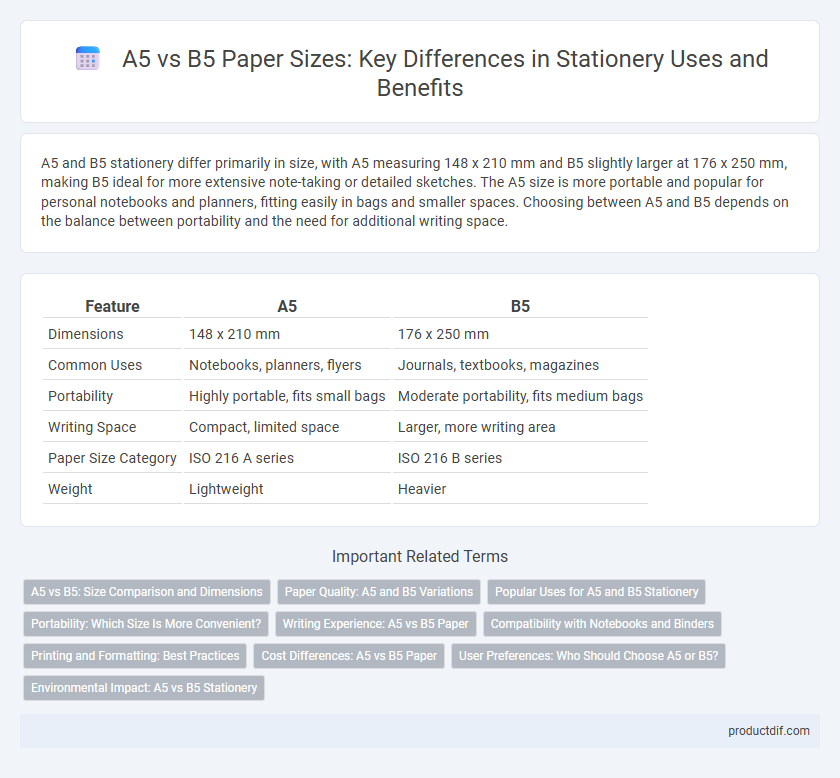A5 and B5 stationery differ primarily in size, with A5 measuring 148 x 210 mm and B5 slightly larger at 176 x 250 mm, making B5 ideal for more extensive note-taking or detailed sketches. The A5 size is more portable and popular for personal notebooks and planners, fitting easily in bags and smaller spaces. Choosing between A5 and B5 depends on the balance between portability and the need for additional writing space.
Table of Comparison
| Feature | A5 | B5 |
|---|---|---|
| Dimensions | 148 x 210 mm | 176 x 250 mm |
| Common Uses | Notebooks, planners, flyers | Journals, textbooks, magazines |
| Portability | Highly portable, fits small bags | Moderate portability, fits medium bags |
| Writing Space | Compact, limited space | Larger, more writing area |
| Paper Size Category | ISO 216 A series | ISO 216 B series |
| Weight | Lightweight | Heavier |
A5 vs B5: Size Comparison and Dimensions
A5 paper measures 148 x 210 mm, making it smaller and more compact than B5, which measures 176 x 250 mm. The difference in size affects usability, with A5 ideal for portable notebooks and planners, while B5 offers more writing space suited for detailed notes or documents. Understanding these dimensions helps users choose the appropriate stationery for tasks requiring mobility or expanded writing area.
Paper Quality: A5 and B5 Variations
A5 and B5 paper sizes offer distinct variations in quality based on thickness and finish options commonly available, with B5 often favored for professional printing due to its slightly larger dimensions and better weight distribution. A5 paper typically suits personal notes or lightweight documents, featuring standard 70-80gsm weight, while B5 options include heavier 90-120gsm stocks, enhancing durability and print clarity. Both sizes can be found in matte or glossy finishes, but B5's superior surface texture supports more vibrant color reproduction and smoother ink absorption.
Popular Uses for A5 and B5 Stationery
A5 stationery is widely favored for personal journals, planners, and portable notebooks due to its compact size and ease of handling, making it ideal for daily use and note-taking on the go. B5 stationery is popular in academic and professional settings, commonly used for reports, official documents, and sketchbooks, offering a slightly larger writing surface that balances portability with ample space. Both sizes accommodate various paper types and bindings, catering to diverse organizational and creative needs.
Portability: Which Size Is More Convenient?
A5 notebooks, measuring 148 x 210 mm, offer superior portability compared to B5 notebooks, which are larger at 176 x 250 mm, making A5 easier to carry in small bags or even pockets. The compact size of A5 allows for convenient on-the-go note-taking without added bulk, ideal for students and professionals who prioritize mobility. B5 notebooks, while providing more writing space, may require larger carrying cases, reducing convenience for daily transport.
Writing Experience: A5 vs B5 Paper
A5 paper, measuring 148 x 210 mm, offers a compact writing surface ideal for quick notes and portability, making it favored for journaling and everyday use. B5 paper, at 176 x 250 mm, provides a larger space that enhances comfort for extensive writing tasks, reducing hand fatigue and improving handwriting clarity. The increased surface area of B5 paper supports better ink absorption and less bleed-through, contributing to a smoother and more enjoyable writing experience compared to A5.
Compatibility with Notebooks and Binders
A5 notebooks measure 148 x 210 mm, making them highly compatible with smaller binders and portable folders, ideal for compact note-taking. B5 notebooks, sized at 176 x 250 mm, offer a larger writing area and fit standard-sized binders used frequently in academic and office settings. Compatibility with ring binders and organizers varies, with B5 notebooks better suited for typical business binders, while A5 is preferred for travel-friendly, lightweight stationery.
Printing and Formatting: Best Practices
When choosing between A5 and B5 stationery formats, prioritize print resolution and layout dimensions to ensure accurate text and image reproduction. A5 measures 148 x 210 mm, ideal for compact documents with limited content, while B5 at 176 x 250 mm offers more space for detailed formatting and larger margins. Adjust DPI settings and margin sizes according to the selected paper size to avoid clipping and maintain a professional appearance.
Cost Differences: A5 vs B5 Paper
A5 paper is generally more cost-effective than B5 paper due to its smaller size, resulting in lower material and shipping expenses. Bulk purchasing of A5 sheets often leads to better pricing per unit compared to B5, making it a preferred choice for budget-conscious businesses. B5 paper, being larger, usually incurs higher production costs and retail prices, impacting overall stationery budgets.
User Preferences: Who Should Choose A5 or B5?
A5 notebooks are ideal for users seeking a compact, portable option for quick notes, ideal for students and professionals who prioritize convenience and easy carrying. B5 sizes offer a larger writing surface, benefiting individuals who require more space for detailed notes or sketches, such as designers and researchers. Choosing between A5 and B5 depends on balancing portability with the need for ample writing area based on personal or professional demands.
Environmental Impact: A5 vs B5 Stationery
A5 stationery typically uses less paper than B5 due to its smaller size (148 x 210 mm for A5 vs. 176 x 250 mm for B5), resulting in reduced raw material consumption and lower carbon emissions during production. The manufacturing process for B5 stationery often involves more energy and water usage because of its increased dimensions and weight. Choosing A5 over B5 can contribute to minimized waste and a smaller environmental footprint, aligning with sustainable office practices.
A5 vs B5 Infographic

 productdif.com
productdif.com